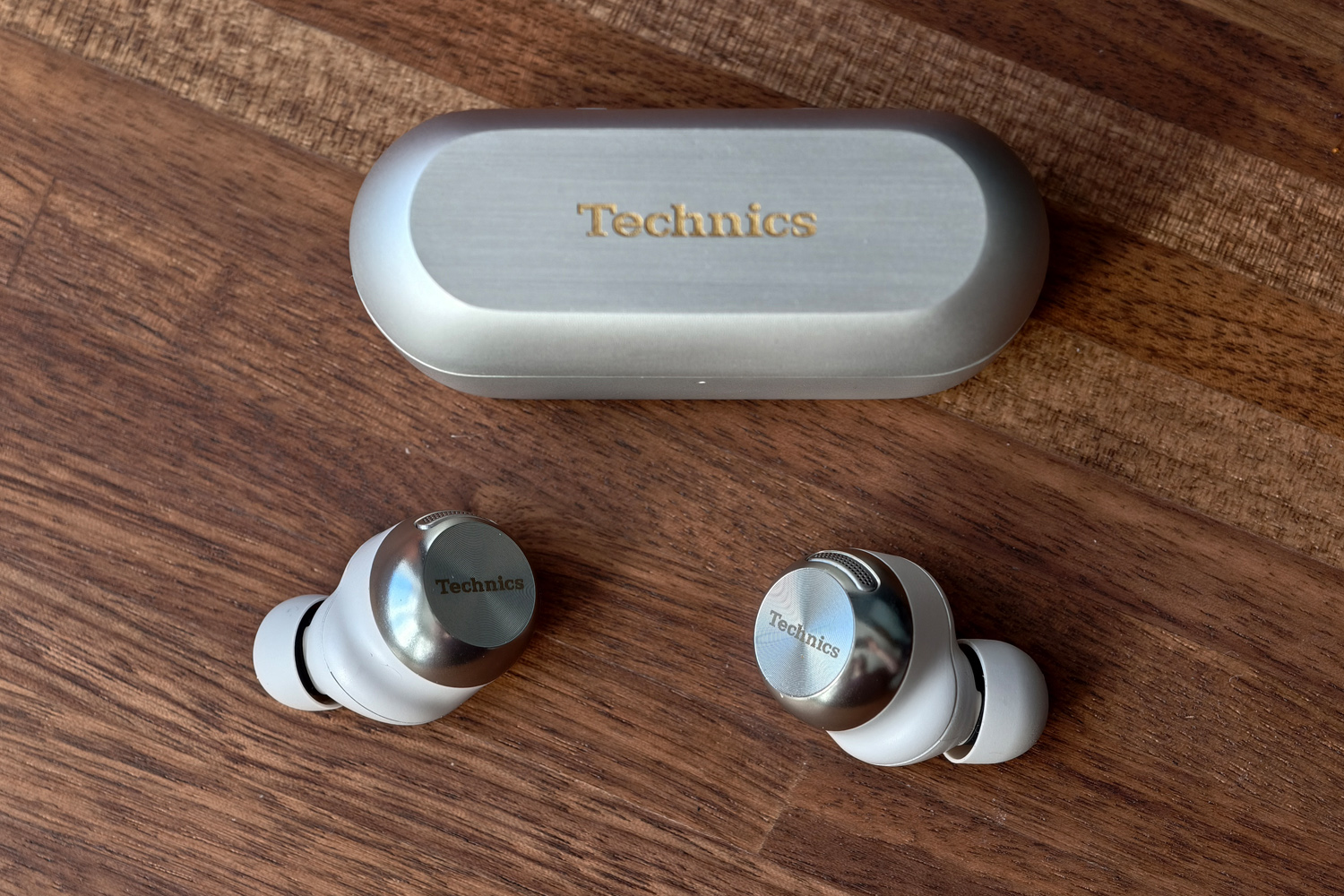Introduction
Technics set a high bar for itself when it launched the EAH-AZ80 back in 2023. It wanted to be the everyman of wireless earbuds: besting Bose for noise cancelling and comfort, schooling Sennheiser and Sony on sound quality, and sitting secure enough to be your workout soundtrack.
I was a big fan, even if they didn’t quite reach those lofty heights in a few areas – and quickly counted the likes of Sony’s WF1000-XM5 and the Bose QuietComfort Ultra Earbuds as rivals. The new EAH-AZ100 aims to reestablish the pecking order, using a new version of the magnetic fluid driver tech used in the EAH-TZ700 – which were about as high-end as single-driver wired earphones got at the time.
Add in spatial sound, longer battery life and future-proof connectivity, and these £259 / €299 in-ears might just be the total package.
Design & build: circular evolution

The AZ100 has a lot in common with the Technics EAH-AZ80, including the same choice of subtle black or more distinctive silver colours, but the overall look is that little bit more refined here. Technics has gone for a fully round shape instead of a teardrop one, and ditched the contrasting metal trim.
It’s a small change, but one that makes each bud look considerably smaller and sleeker. In reality they’re only about 10% smaller, and weigh just a little bit less (5.9g to the AZ80’s 7g). While the driver housing sticks with the same concha fit, the buds sit that little bit more flush in your ears. I was able to sleep while wearing these earbuds, which I couldn’t do comfortably with the AZ80.
The sculpted shape works well to keep the buds secure while you’re moving around, so I could jog without them falling use – something I still can’t say for every pair of earphones I test. They stayed comfortable for long listening sessions, too. I partly chalk that up to the five silicone ear tips included in the box. Each pair uses a new three-layer design that makes them soft and malleable where they touch your ears, but hard around the earbud connector to help keep sound leakage to a minimum. They work well, with my wife unable to hear anything I was listening to while I was sat next to her on the sofa.
The charging case is usefully smaller than the AZ80’s, slipping more easily into my jeans pockets. It’s still made from a mix of metal and plastic, and keeps the tiny activity LED to show how much battery is left when you flip the lid.
Features & battery: lasts longer
Technics threw its hat in with LDAC high quality Bluetooth for the AZ80, and that hasn’t changed for the new flagship. You won’t find any sort of aptX codec here, so devices that don’t support LDAC will fall back to more basic SBC or AAC. These earphones are a lot more future proof, though, with Bluetooth LE and LC3 support. That includes Auracast, for pairing and sharing to public broadcasts once the tech sees wider adoption.
It’s great to see three-device multipoint connectivity return, although only when connected over SBC or AAC; use LDAC and you’re limited to two devices, with the companion app recommending you stick to one for an uninterrupted signal. I had no trouble using two devices while at home, but particularly busy areas (like train stations or airport terminals) could cause dropouts on the higher bandwidth codec.
Happily call quality hasn’t taken a dive now Technics has stripped out a microphone from each earbud. Machine learning algorithms use the remaining three mics to dial out background chatter and wind noise. None of the callers I spoke to during testing had any complaints, and the tech worked on incoming audio to make conversations that little bit clearer on my end too.
The buds might’ve shrunk, but battery capacity hasn’t; the AZ100 goes the other way instead, with significantly more lifespan than the AZ80. With LDAC and ANC enabled, they lasted close to seven hours in my testing – up from four and a half on the cheaper model. That’s a bit under an hour less than the class leaders. Stick with AAC, though, and you’ll get closer to ten hours – a near three hour improvement.
The charging case can bring your total listening time to 18 hours (LDAC) or 28 hours (AAC) respectively, without having to disable noise cancelling. It refuels over USB-C in a couple of hours, or Qi wireless in a couple more.
Interface: the great equaliser
Launching the smartphone companion app, it was quickly clear to me that Technics has been paying attention to customer feedback. The ANC now defaults to an adaptive mode, rather than making you pick the cancellation strength manually, and using higher quality LDAC Bluetooth doesn’t lock you out of quite so many features this time around.
The general layout is as clean as ever, with customisable homescreen shortcuts to quickly jump to your more frequently used functions. I ditched the user guide and microphone voice test for a spatial audio toggle and the find headphones button, but there are lots more to choose from and save a trip to the Settings menu.
There’s still no ear tip fit test or listening-based equaliser adjustment, but Technics has made adjusting the sound a whole lot easier. You get an eight-band custom equaliser now, up from a five-band EQ on the AZ80, and three separate custom modes to save your tweaks to. That’s great if you listen to a mix of music genres, or want podcasts to have a little less bass punch. That’s on top of the six baked-in presets, too.
Being able to fully customise the touch controls (instead of just picking from a few preset options) is very welcome. I did think some descriptions of the app’s more advanced settings were a little obtuse, and it’s a shame there’s no way to use spatial sound and LDAC at the same time, but otherwise the AZ100 has an extensive feature set.
Sound quality and noise cancelling: tuning up the band
The new adaptive ANC mode is on by default, and quickly ramps up the cancellation effect when you step from a quiet place into a loud one. It’s not overbearing, and produces the mildest audible hiss that i could only detect when sitting in silence; it vanished when listening to a spoken word podcast. Of course there’s an ambient mode if you want a better sense of your surroundings, and you can adjust the ANC strength manually if you like, but I preferred to leave the AZ100 to do its own thing.
I already thought Technics had a good grip on its ANC algorithms, but these earphones still score top marks for how well they muted my surroundings. It had no issues with public transport, coped well when walking along roads with lots of passing traffic, and office noise didn’t seep through either. If the AZ80 was a half-step behind its rivals, I’d say the AZ100 has caught up – even if Bose continues to do astonishing work with its flagship buds.
It has made noticeable gains when it comes to sound quality, too. Technics has stuck with a single 10mm dynamic driver, but uses a new iteration of the magnetic fluid tech seen in the TZ700 wired in-ear monitors – which cost an eye-watering £1100/$1400 at launch back in 2020. Filling the space between the driver magnet and voice coil with an oil-like magnetic liquid noticeably lowers distortion, while other mechanical tweaks sharpen bass response compared to the AZ80.
The result is a more delicate and defined frequency range, with crisp and detailed treble notes that sit on the right side of sharp. The scratchy rave crescendo of Burial’s Dreamfear can sound piercing and shrill on lesser earphones, but here the highs aren’t so aggressive – without losing the edge intended by the artist.
While far from the widest soundstage I’ve heard from a pair of in-ears, they still avoided sounding too enclosed. Instruments don’t trip over one another across the frequency range, and there’s a satisfying amount of bass without going over the top. I was happy to leave the EQ on Technics’ default, with energetic electronic tracks like Dougal and Gammer’s Your Love Gets Me High having proper low end oomph but bass not creeping into the piano backing on Lana Del Ray’s cover of Take Me Home, Country Roads.
You don’t have to be an audiophile to notice the difference between the AZ80 and AZ100, and there’s a clarity here that compares very favourably with rivals in the £250-£300 price bracket.
Technics EAH-AZ100 verdict
The AZ80 provided a fantastic baseline, but I’m still impressed with how much extra refinement Technics has managed to coax out of the EAH-AZ100. The magnetic fluid tech delivers an impressively well-rounded sound for a single driver setup, helping it take on all comers within its price range.
Not every issue I had with the AZ80 has been addressed, but the most important ones – battery life and limited custom EQ options – have been ticked. Adaptive noise cancelling makes silencing the outside world that bit easier than before, and is almost as effective as the class best. Spacial audio support is a nice inclusion too, if you’re a fan, and wireless connectivity is now fully future-proof.
That they’re smaller and lighter than before, with redesigned ear tips that ramp up the comfort levels even further, only seals the deal.
Technics EAH-AZ100 technical specifications
| Drivers | 10mm magnetic fluid driver |
| ANC | Yes |
| Bluetooth version | Bluetooth 5.3, Bluetooth LE |
| Codecs supported | SBC, AAC, LDAC, Auracast, LC3 |
| Durability | IPX4 |
| Battery life | 10hrs/28hrs (buds/buds and case, ANC on) |
| Dimensions | 21x26x25mm, 5.9g (buds, each) 69x36x27mm, 42g (case) |
Read the full article here
